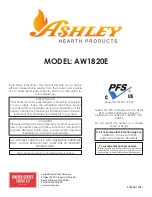
EN
W415-1212 / 05.13.13
66
8.9 WOOD
87.1B
When loading the appliance, ensure that the upper fi bre baffl es are not forced out of position. For maximum effi ciency, when the
appliance is thoroughly hot, load it fully to the top of the door opening and burn at a medium low setting. The whiteness of the
bricks and the cleanliness of the glass are good indicators of your operating effi ciency. Not enough heat is produced when only a
few pieces of wood are burned or the wood may not burn completely.
Fuel for the appliance must not be stored closer than the required clearances to combustibles (heat sensitive material).N
EVER
STORE WOOD IN THE ASH PAN COMPARTMENT (if applicable).
NOTE: When loading the appliance, ensure to keep fuel back from the glass. If coals are to accumulate on the front lip,
there is a chance they will fall out when the door is opened.
Burn only dry, clean unpainted wood that has been seasoned. It produces more
heat and less soot or creosote. Freshly cut wood contains about 50% moisture
while after proper seasoning only about 20% of the
water remains. As wood is burned, this water boils
off consuming energy that should be used in heating.
The wetter the wood, the less heat is given off and
the more creosote is produced. Dry fi rewood has
cracks in the end of the grain.
Both hardwood and softwood burn equally well in this
appliance but hardwood is denser, will weigh more
per cord and burn a little slower and longer.
Firewood should be split, stacked in a manner that air can get to all parts of it and covered in early spring to be ready for
burning that fall. Dry fi rewood has cracks in the end grain.
Cut the wood so that it will fi t horizontally, front to back, making for easier loading and less of a likelihood that the wood will roll
onto the glass.
Manufactured fi relogs made by compressing 100% natural wood fi bre can be safely used as fuel. Do not use manufactured
fi relogs if they contain additives such as paraffi n, wax, binders etc. Never burn more than two manufactured fi relogs at a time.
DO’S
•
Build a hot fi re.
•
Use only dry wood.
•
Several pieces of medium sized wood are better
than a few big pieces.
•
Clean chimney regularly.
•
Refuel frequently using medium sized wood.
•
“Fine Tune” the air settings for optimum
performance.
DONT’S
•
Take ash out immediately. Let it accumulate to a
depth of at least one inch. A good ash layer provides
for a longer lasting and better burning fi re.
•
Burn wet wood.
•
Close the door too soon or damper down too quickly.
•
Burn one large log rather than two or three smaller,
more reasonably sized logs.
•
Burn at continually “low setting”, if glass door is
constantly blackened. This means the fi rebox
temperature is too low.
THIS APPLIANCE IS DESIGNED TO BURN NATURAL WOOD ONLY. DO NOT BURN TREATED
WOOD, COAL, CHARCOAL, COLOURED PAPER, CARDBOARD, SOLVENTS OR GARBAGE. THIS
APPLIANCE HAS NOT BEEN TESTED WITH AN UNVENTED GAS LOG SET. TO REDUCE RISK OF FIRE
OR INJURY, DO NOT INSTALL AN UNVENTED GAS LOG SET INTO THE APPLIANCE.
HIGHER EFFICIENCIES AND LOWER EMISSIONS GENERALLY RESULT WHEN BURNING AIR DRIED
SEASONED HARDWOODS, AS COMPARED TO SOFTWOODS OR TOO GREEN OR FRESHLY CUT
HARDWOODS.
BURNING WET UNSEASONED WOOD CAN CAUSE EXCESSIVE CREOSOTE ACCUMULATION. WHEN
IGNITED IT CAN CAUSE A CHIMNEY FIRE THAT MAY RESULT IN A SERIOUS HOUSE FIRE.
DO NOT STORE FUEL WITHIN THE CLEARANCE TO COMBUSTIBLES, OR IN THE SPACE REQUIRED
FOR RE-FUELING AND ASH REMOVAL.







































